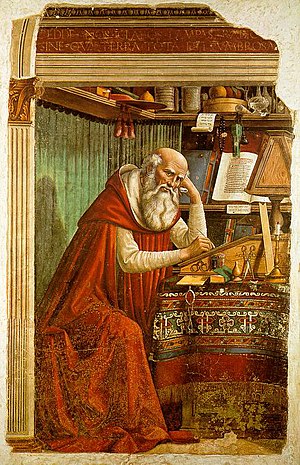I am just starting my lectures on the origin and purpose
of the "five books of Moses" and my first-year graduate students are
getting excited about reading the Pentateuchal texts. Before that though they
need to be introduced to the origins and purpose of the Torah and I am sure
there would be a lot of questions. Here is a brief exposition on what I plan to
cover in the first few classes.
 The first five books of the Hebrew Scriptures are known
as the Pentateuch (Gk. πἐντε [pente= five]; τεῦχος [teuchos = case]). These books are essentially arranged in the form of a narrative that
begins with the creation of the world and finishes with the death of Moses,
right before the people of Israel make their entry into the Promised Land.
Although these books contain a great amount of legislature and regulations, in
actual fact they are not books of law.
The first five books of the Hebrew Scriptures are known
as the Pentateuch (Gk. πἐντε [pente= five]; τεῦχος [teuchos = case]). These books are essentially arranged in the form of a narrative that
begins with the creation of the world and finishes with the death of Moses,
right before the people of Israel make their entry into the Promised Land.
Although these books contain a great amount of legislature and regulations, in
actual fact they are not books of law.
The Hebrew term תוֹרָה (Torah), by which the
Pentateuch is known, is most of the times conventionally translated as “law”,
but its meaning is better represented as “teaching”, “guidance” or
“instruction”. Therefore the Pentateuch does not present itself as a
comprehensive set of rules for life, nor does it develop a consistent
theological system, nor does it typically narrate the past to illustrate
obvious or explicit moral truths.
Although in most centuries the Pentateuch has been known
as “the five books of Moses”, perhaps because he is the major human figure in
the narrative, it has long been acknowledged that he cannot have been the human
author, and that the Pentateuch is in fact anonymous. Some scholars believe that
within the Pentateuch itself, Moses could be attributed with the
authorship of relatively small portions of its contents: Exodus 21-23, the laws
known as the “Book of the Covenant”; Numbers 33, the itinerary of Israel in the
wilderness; Deuteronomy 5:6-21, the Ten Commandments. These sections are among
the elements generally considered most ancient by historical specialists. I
find this most interesting. Whether or not Moses can be called the author
in a literal sense of anything in the Pentateuch, it is not impossible to hold
that the work and teaching of a historical figure were the stimulus for the
formation of the Pentateuch.
The overwhelming tendency in biblical scholarship has
been to explain the origin of the Pentateuch as the outcome of a process of
compilation of various documents, or better now, traditions or sources from
different periods of Israelite history. According to the classical
Documentary Theory of the Pentateuch, formulated by Julius Wellhausen and
others in the nineteenth century, the oldest written source of the Pentateuch
was the document J (so called from its 'author', the Jawhist or Yawhist, who
used the name יהוה (Yahweh)
for God. This source dates from approximately the ninth century BCE.
The E document (from the Elohist, who employed the Hebrew term אֱלֹהִם (ʼĕlohīm) for God, would have originated during the eighth
century. Many scholars think that the J and E sources were combined
by an editor in the mid-seventh century. The book of Deuteronomy, a separate
source dating from 621 BCE was added to the JE material in the mid-six century.
The final major source, the Priestly work (P), was mingled to the earlier
sources about 400 BCE. With all of this, the Pentateuch as we know
it probably came into existence no earlier than the end of the fifth
century BCE. Nothing that I have mentioned here concerning this
process remains unchallenged, and indeed the theory as a whole can no longer be
called the consensus view. It has become clearer with time that the written
documents' proposition is not holding well anymore and that most scholars
prefer now to talk more about the JEDP work as sources or traditions;
nevertheless, no other theory has gained any wide support.
At this point, the question would be: what is the
organizing principle of the Pentateuch as a whole, that is, considered as a
literary entity? An initial answer is obviously that the subject matter of the
Pentateuch is sufficiently unified to create the impression of general
coherence in the work. The last four books, beginning with the birth of Moses
and ending with his death, have a strong narrative connection. However, as I
agree with the vast majority of scholars, it is not accurate to regard the
Pentateuch as primarily a 'biography of Moses', for then there would be no
evident connection between these last four books and Genesis, for this book is
a narrative of the ancestors of Israel in general and not especially of Moses’
forebears.
Some authors have suggested that certain brief summaries
of the Pentateuchal narrative found in Deut. 26:5-10 and 6:20-24, indicate the
fundamental story line of the Pentateuch as a whole. These texts seem to have
the character of Israelite confessions of faith in the God who had directed
their history. These essential elements expressed in these passages express
certain “profession of faith” which corresponds (although roughly) with the
content of the Pentateuch. However, the events at Sinai are remarkably omitted
and anyone would acknowledge they are considered a major section in the Pentateuchal
narrative. Therefore, we would need a more conceptually unified theme in the
Pentateuch than a simple summary of its narrative.
I agree with many scholars’ opinion that the mainspring
of the action in the Pentateuch seems to be the divine promises mentioned in
Genesis 12:1-3 (that are repeated with various emphases in 15:4-5, 13-16,
18-21; 17:4-8; 22:16-18; which also are alluded in some other passages
throughout the Pentateuch). This promise contains three elements: a posterity
(“I will make you a great nation” v.2a) a relationship (“I will bless you”
v.2b) and a gift of land (“the land I will show you” v. 1b). In this
fulfillment and the partial non fulfillment of these promises we can see the
theme that would permeate the whole narrative of the Pentateuch.
 |
The Synagogue in Amsterdam
(Photo credit: photoikon.com) |
The theme of the posterity is is the evident motif of the
Book of Genesis. We can see in the Abraham cycle of stories the significance of
the many Genesis narratives of threats to the family survival: the sterility of
matriarchs (11:30; 25:21; 29:31), the strife between brothers (often with
near-fatal consequences, 4:8; 21:8-19; 25:23, 26; 27:42-45; 37:11, 23-24, 36),
and the repeated famines and difficulties in the land of promise (3:17-19;
12:10; 26:1; 42:5).
The theme of divine-human relationship is expressed most
strongly in the Books of Exodus and Leviticus. The events of the Exodus (10-15)
and the theophany at Mount Sinai (19) explain what the words of the promise (“I
will bless you”, “I will make may covenant between me and you”, “I will be your
God”) meant. The blessing comes in the form of salvation from Egypt and the
gift of the Law. The covenant of Sinai, of which the opening words are “I am
YHWH your God” (20:1) formalize the relationship foreshadowed by the covenant
with the forebears. The Book of Leviticus describes how the relationship now
established by YHWH is to be maintained. Therefore the sacrificial system is to
exist, not as a human means of access to God, but as the divinely ordered
method to repair and atone for failures in keeping the covenant. Finally, the
theme of the land dominates the books of Numbers and Deuteronomy. Numbers
begins with preparations for the conquest of the land, and ends with the actual
occupation of that part at the east of the Jordan by two and a half tribes.
Deuteronomy sets before the people laws for their life under God, explicitly
“in the land which YHWH, God of our fathers, is giving to you” (Deut. 4:1).
Now, none of the promises is fully realized
within the narrative of the Pentateuch itself. The posterity as ‘numerous as
the sand on the seashore’ is a promise that has only begun to see its
realization by the time the Pentateuch is over. The relationship of blessing
and of covenant is a continuing and never completely fulfilled promise, and the
land, at the end of the narrative of the Pentateuch is a promise that is
partially fulfilled. The whole structure of the Pentateuch, therefore,
seems to be shaped by the promises to Abraham, which are never final but always
point beyond themselves to a future yet to be realized. Although this opinion I
share with others is also susceptible to challenge, since I acknowledge that
there are several more ways where we can find some cohesion within the
Pentateuch, (as many as Theology of the OT textbooks present) so far this is
the one that makes more sense to me.
These considerations should serve as a basic
review or reading guideline when non-experts approach the Pentateuch writings. Our hope is to make their study more fruitful and
appealing.











